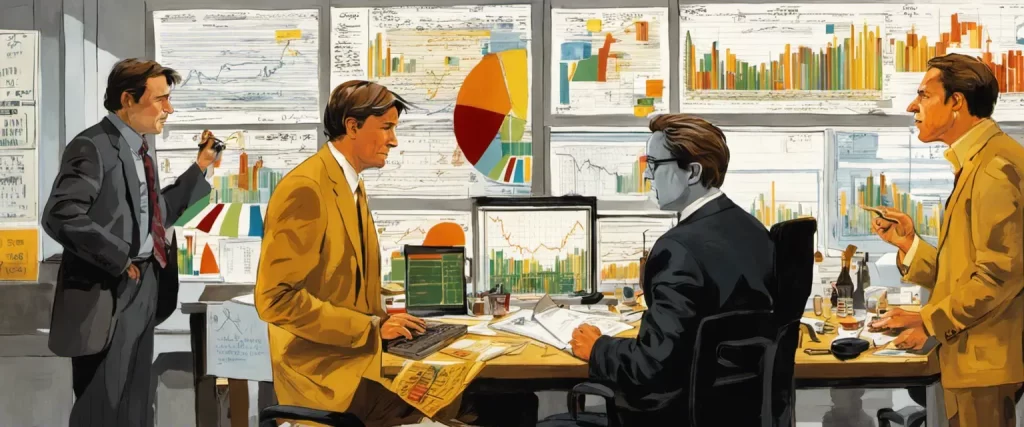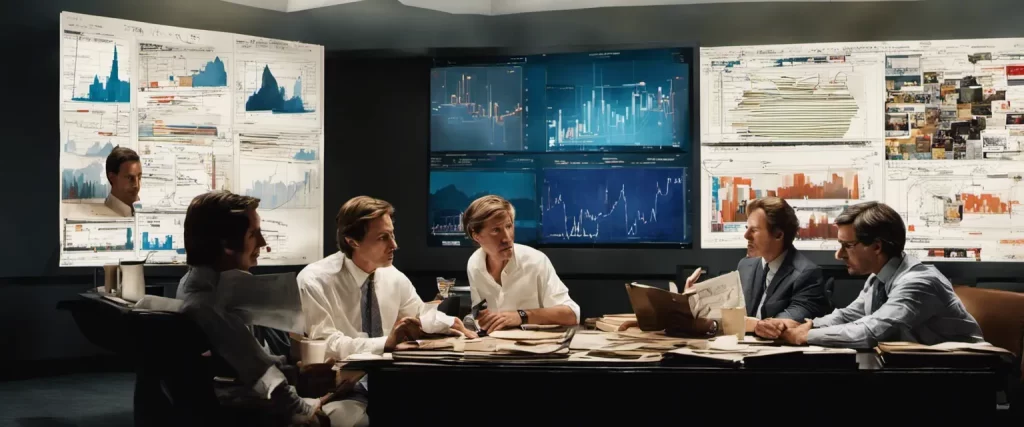
Can you explain ‘The Big Short’ briefly?
“The Big Short” is a non-fiction book written by Michael Lewis, published in 2010. The book explores the events leading up to the 2008 financial crisis and the individuals who predicted and profited from the collapse of the subprime mortgage market in the United States.
Lewis tells the story through the eyes of several key characters, including hedge fund managers, investors, and analysts who recognized the flaws and risks inherent in the housing market. These individuals saw the imminent crisis and decided to bet against the market by creating and investing in financial instruments called credit default swaps (CDS) that would profit from the collapse.
The Big Short” goes into great detail explaining the complex financial mechanisms and flaws in the mortgage industry that fueled the crisis. It highlights how Wall Street banks, rating agencies, and regulatory bodies failed to understand or acknowledge the unsustainable risks involved in the subprime mortgage market and how these risks ultimately led to a worldwide economic meltdown.
The book sheds light on the greedy and risky behavior within the financial sector that contributed to the crisis. It also critiques the lack of accountability and the systemic failures in the financial system that allowed such a catastrophic event to occur.
Overall, “The Big Short” offers an accessible and captivating account of the individuals who, against prevailing beliefs and conventional wisdom, foresaw the impending financial disaster and took advantage of it, while also addressing the larger issues within the financial industry and its impact on the global economy.
What do economists think of The Big Short?
The Big Short” by Michael Lewis, which explores the causes and consequences of the 2008 financial crisis, is generally highly regarded by economists. It is praised for its engaging storytelling and lucid explanations of complex financial concepts, making it accessible to non-experts. By highlighting the role of greed, ignorance, and systemic failures, Lewis provides a critical analysis of the financial industry and its role in the crisis.
Economists appreciate the book for shedding light on the intricate mechanisms that led to the housing bubble, subprime mortgage crisis, and subsequent collapse of the financial system. It exposes many issues within the industry, such as the mispricing of risk, conflicts of interest, and the lack of regulatory oversight. Economists find the book to be a valuable resource for understanding the financial crisis, as it offers insights into both the economic and human aspects of the events.
However, some economists argue that the book oversimplifies certain aspects or fails to emphasize important factors. They contend that it portrays the crisis as solely caused by the malfeasance of a handful of individuals or firms, overlooking broader systemic issues. Additionally, while Lewis highlights the profit made by those who foresaw the crisis and bet against it, some economists caution that this may create a skewed impression of financial markets, as there are always winners and losers in any market.
Overall, “The Big Short” is widely appreciated by economists as a thought-provoking and informative book that effectively captures the complexities and flaws of the financial system leading up to the 2008 crisis.
How did Steve Carrell make money in The Big Short?
In the book “The Big Short: Inside the Doomsday Machine” by Michael Lewis, Steve Carell’s character, Mark Baum, is a hedge fund manager and one of the central figures in the story. The book explores the events leading up to the 2008 global financial crisis.
Mark Baum, based on a real person named Steve Eisman, made money in “The Big Short” by shorting the housing market. He recognized the flaws in the housing market and the subprime mortgage bonds that were being sold, believing that those bonds were bound to fail. By shorting the market, he effectively bet that the housing market would collapse.
When the housing market did crash, the value of the mortgage-backed securities plummeted, and those who had shorted the market profited from the decline. This included Mark Baum and his hedge fund team, who were portrayed by Steve Carell in the subsequent film adaptation of the book.

How has Wall Street changed since The Big Short?
“The Big Short” written by Michael Lewis was published in 2010, and it provides an insider’s look at the causes and aftermath of the 2007-2008 financial crisis. Since the publication of the book, several changes have occurred in Wall Street as a result of the crisis and subsequent regulatory responses. Here are some of the key changes:
1. Regulatory reforms: The financial crisis prompted significant regulatory changes to prevent a similar collapse in the future. The Dodd-Frank Wall Street Reform and Consumer Protection Act was passed in 2010, aimed at increasing oversight and transparency in the financial industry. It established new regulations for banks, credit rating agencies, and mortgage lenders.
2. Increased oversight and transparency: Regulatory bodies such as the Securities and Exchange Commission (SEC) and the Financial Industry Regulatory Authority (FINRA) have increased their monitoring and enforcement activities to mitigate risks in the financial markets. There is a greater emphasis on ensuring accurate financial reporting and preventing fraudulent practices.
3. Stricter lending standards: The financial crisis was largely attributed to irresponsible lending practices and the securitization of low-quality mortgages. In response, there has been a tightening of lending standards, making it more difficult for borrowers to obtain mortgages and other forms of credit.
4. Volcker Rule: As a part of the Dodd-Frank Act, the Volcker Rule prohibits banks from engaging in proprietary trading (trading with their own funds rather than on behalf of customers) and restricts their ownership in hedge funds and private equity funds. It aims to prevent banks from taking excessive risks that could harm the overall financial system.
5. Improved risk management practices: Financial institutions have implemented more rigorous risk management practices to better assess and manage the various risks they face. This includes stress testing, enhanced risk assessment models, and stricter risk governance policies.
6. Increased focus on ethics and accountability: The financial crisis exposed many unethical practices within the financial industry. As a result, there has been a greater emphasis on ethics and accountability, including the implementation of codes of conduct, stronger internal control systems, and whistleblower protections.
7. Technology-driven changes: The financial industry has undergone significant technological advancements since the publication of the book. The rise of fintech (financial technology) has disrupted traditional financial services and led to the development of new business models and ways of investing. Electronic trading, algorithmic trading, and high-frequency trading have become more prevalent.
While these changes have aimed to address the issues identified in “The Big Short,” it is essential to acknowledge that concerns about the stability and integrity of the financial system continue to persist. The impact of these changes and ongoing debates on financial regulation remain subjects of discussion among policymakers, economists, and industry professionals.
In the Big Short, how did they make money from selling CDS?
In “The Big Short,” some investors made money from selling Credit Default Swaps (CDS) by essentially betting against the stability of the mortgage market. Here’s an explanation of how they did it:
1. Understanding CDS: A CDS is a type of financial derivative that acts as an insurance contract against the default of a specific debt instrument (often mortgage-backed securities). The seller of the CDS agrees to compensate the buyer if the debt instrument defaults.
2. Perception of Inflated Housing Market: The investors featured in the movie (and the book it was based on) noticed that the housing market seemed overinflated, with an increasing number of subprime mortgages being issued to borrowers with weak credit histories.
3. Shorting Mortgage-Backed Securities (MBS): These investors wanted to take a “short” position on mortgage-backed securities, meaning they were betting that the value of these securities would decline. To do this, they had to find a way to profit if the mortgage market collapsed.
4. Buying CDS: They purchased CDS from banks and financial institutions, which were willing to sell them as they believed that the housing market was stable and mortgage defaults were unlikely. By buying these CDS, the investors effectively placed a bet that the housing market would crash and many mortgages would default.
5. Premium Payments: To own the CDS, the investors had to make periodic premium payments to the banks or financial institutions that had sold them the contracts. These premium payments were usually relatively low, making it an attractive investment.
6. Mortgage Market Collapse: As the subprime mortgage market began to collapse, with increasing numbers of mortgage defaults and foreclosures, the value of the CDS held by these investors skyrocketed. This substantial increase in value allowed them to profit significantly.
7. Cashing Out: The investors then sold their CDS contracts back to the banks or financial institutions at much higher prices due to the increased risk. This allowed them to make substantial profits.
In summary, the investors made money from selling CDS by essentially betting against the stability of the mortgage market. As the market collapsed and mortgage defaults increased, the value of their CDS contracts rose, allowing them to cash out and make significant profit.
What is the reason for the low prices of credit default swaps?
There are several reasons for the low prices of credit default swaps (CDS):
1. Perception of low default risk: If investors perceive low default risk for the underlying asset (such as a company or sovereign debt), the demand for CDS protection decreases, leading to lower prices. This can happen when the economy is performing well or when the company’s financial health is strong.
2. Market competition: The pricing of CDS is influenced by market competition among buyers and sellers. If there are many sellers offering CDS contracts, they may compete by lowering prices to attract buyers, resulting in lower overall prices.
3. Lack of liquidity: If the market for CDS is illiquid or does not have many active participants, it can lead to low prices. Illiquidity makes it challenging for market participants to trade, increasing the costs and reducing demand for CDS contracts, thus lowering prices.
4. Regulation and oversight: After the global financial crisis of 2008, regulatory measures such as improved risk management practices and increased capital requirements have enhanced market stability. This, in turn, has led to lower perceived default risk and subsequently lower CDS prices.
5. Investor sentiment and market conditions: Positive investor sentiment, economic stability, or overall market optimism can decrease the perceived risk of default, resulting in lower CDS prices. Conversely, negative sentiment or economic instability can increase default risk perception and consequently increase CDS prices.
It’s worth noting that the low prices of CDS can sometimes be misleading and do not always accurately reflect the underlying risk. The financial crisis highlighted instances where CDS prices were too low, as they failed to predict the high default rates experienced by certain assets.
What morals did the Big Short teach us?
“The Big Short” is a non-fiction book written by Michael Lewis, which explores the events leading up to the financial crisis of 2008. The book offers several important lessons or morals:
1. Moral hazard: One of the primary lessons of the book is the existence of moral hazard within the financial industry. The reckless and irresponsible behavior of banks, rating agencies, and government regulators, who all knowingly engaged in risky practices, had severe consequences for the global economy. It highlights the danger of a system where those who take risks are not held accountable for their actions.
2. Greed and self-interest: “The Big Short” exposes the excessive greed and self-interest that dominated the financial sector, with many individuals and institutions pursuing short-term gains at the expense of long-term stability. It depicts how this mentality can lead to the exploitation and manipulation of markets.
3. Lack of transparency and accountability: The book sheds light on the lack of transparency and accountability within the financial industry, highlighting the complex and obscure financial instruments created and traded by Wall Street. It demonstrates how this lack of understanding of the risks associated with these instruments ultimately led to the disastrous consequences of the financial crisis.
4. Complexity and systemic risk: “The Big Short” emphasizes the dangers of a financial system that is overly complex and difficult to understand. It reveals how the intertwining of various financial products and institutions created systemic risks, making it impossible to predict the domino effect that would ultimately collapse the global economy.
5. Skepticism and critical thinking: The protagonists of the book, the few who saw the impending collapse and bet against the system, displayed skepticism and critical thinking skills. They questioned the prevailing belief that the housing market would continue to rise indefinitely. “The Big Short” encourages readers to challenge accepted narratives and conduct their own research before making financial decisions.
Overall, the book teaches us about the potential consequences of unchecked greed, the importance of transparency and accountability, and the need to critically analyze complex systems.

Is Michael Burry respected on Wall Street?
Yes, Michael Burry is widely respected on Wall Street for his work as an investor and for his accurate predictions during the 2008 financial crisis. He gained significant attention and respect for his successful bet against the US housing market, which was detailed in the book “The Big Short” by Michael Lewis. Burry’s analysis and foresight in recognizing the impending housing bubble collapse earned him a great deal of credibility in the financial industry, and his investment strategy has been highly regarded by many professionals.
What makes Michael Lewis such a successful author?
There are several factors that contribute to Michael Lewis’ success as an author:
1. Engaging storytelling: Lewis has a unique ability to take complex financial or sports subjects and turn them into compelling narratives. He combines his strong reporting skills with storytelling techniques to make his books accessible and entertaining to a wide audience.
2. Deep research and extensive interviews: Lewis spends months, and sometimes years, conducting thorough research and interviews with key individuals to gather firsthand information and insights. This dedication to in-depth reporting allows him to offer a comprehensive and well-informed perspective, adding credibility to his work.
3. Ability to translate complex subjects: Lewis has a talent for explaining complex concepts and making them understandable to readers who may not have a background in the subject matter. Whether he is demystifying financial markets or explaining the intricacies of professional sports, he breaks down complicated ideas into clear and digestible narratives.
4. Timeliness and relevance: Lewis often writes about current events and topics that are highly relevant to society. By focusing on issues that captivate public interest, he taps into a demand for information and analysis, ensuring a wide readership for his books.
5. Strong critical acclaim and word-of-mouth recommendation: Lewis has received numerous awards and critical acclaim for his writing, which has helped establish him as a respected author. Positive reviews and word-of-mouth recommendations from readers have contributed to his success by driving book sales and introducing his work to new audiences.
6. Previous success and established fanbase: With previous successful books like “Liar’s Poker” and “Moneyball,” Lewis has built a loyal fanbase that eagerly awaits his new releases. This existing fanbase provides a solid foundation for his books’ popularity and ensures a certain level of anticipation and interest around his work.
Overall, Michael Lewis’ success as an author can be attributed to his storytelling skills, thorough research, relevance of his topics, critical acclaim, and an established fanbase.
Book Recommendation for the people who loved The Big Short by Michael Lewis
1. Liar’s Poker: Rising Through the Wreckage on Wall Street” by Michael Lewis
2. Too Big to Fail: The Inside Story of How Wall Street and Washington Fought to Save the Financial System–and Themselves” by Andrew Ross Sorkin
3. “Flash Boys: A Wall Street Revolt” by Michael Lewis
4. “Black Edge: Inside Information, Dirty Money, and the Quest to Bring Down the Most Wanted Man on Wall Street” by Sheelah Kolhatkar
5. “The Quants: How a New Breed of Math Whizzes Conquered Wall Street and Nearly Destroyed It” by Scott Patterson
6. The Smartest Guys in the Room: The Amazing Rise and Scandalous Fall of Enron” by Bethany McLean and Peter Elkind
7. “The Money Culture” by Michael Lewis
8. “Fool’s Gold: How the Bold Dream of a Small Tribe at J.P. Morgan Was Corrupted by Wall Street Greed and Unleashed a Catastrophe” by Gillian Tett
9. “Boomerang: Travels in the New Third World” by Michael Lewis
10. “The Panic of 1907: Lessons Learned from the Market’s Perfect Storm” by Robert F. Bruner and Sean D. Carr
